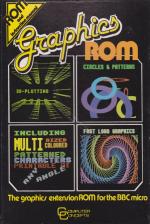
Beebug
 1st May 1984
1st May 1984
Categories: Review: Software
Author: Mike Siggins
Publisher: Computer Concepts
Machine: BBC Model B
Published in Beebug Volume 3 Number 1
Computer Concepts Graphics ROM (Computer Concepts)
Product: Graphics Extension ROM
Price: £33.35
Supplier: Computer Concepts, 16 Wayside, Chipperfield, Herts WD4 9JJ
The Graphics Extension ROM is a welcome addition to the growing range of graphics software and add-ons now available for the BBC micro. The ROM provides many features, including sprites and turtle graphics, to supplement the already extensive routines available on the Beeb. There are, in addition to this, some general purpose commands which provide useful additions to the graphics capability of the Beeb. All the commands are accessible from Basic, in the manner of standard 'star' commands.
The ROM is packaged to the normal professional standards associated with previous products from Computer Concepts. Installation is simply a matter of inserting the ROM into a socket, preferably one of high priority for speed. The documentation supplied is of a good standard, providing detailed and clear explanations of all the commands and parameters.
The sprite commands are very comprehensive and provide the basis for animation techniques. Commands are provided to create, edit and display up to 32 multi-coloured sprites which can be up to 24 pixels square. They can then be combined to produce animated sequences using the powerful *FILM command. The only problem here is the knowledge of the memory map required to derive the best results, especially considering the limited memory available. The speed with which the sprites can be moved about is impressive, and can be extremely smooth. The worst results are experienced when the sprites are moved diagonally.
The Turtle graphics commands emulate those available in the Logo language. The range covered gives all the primitives for some very interesting graphics. The speed is again impressive, and would probably benefit from some delay routines if the commands were used in the context of a Logo interpreter. As one would expect, all the colours are available making for some very spectacular displays.
There are many other commands which all go to provide a utility worthy of extended experimentation. They include a versatile plot command which can use the existing Basic parameters and combine them with 3-D co-ordinates. These routines can provide some amazing effects. There is also a print command which can display text at any angle, size or colour. The output is unfortunately somewhat untidy as it seems to merely magnify the existing character set. This causes unsightly 'steps' as the characters grow in size.
Other commands enable one to scale and rotate the screen, compose spiral patterns, rapidly draw arcs and circles. An extremely useful item is a system of 'GFX' commands which provide a suite of utilities for the chip itself, including a powerful sine and cosine look-up facility.
Overall, this product is good value for money and will provide anyone interested in graphics with a whole new field of possibilities. It is worth remembering that any programs developed using these features will only run on a machine in which the Graphics ROM is installed.


